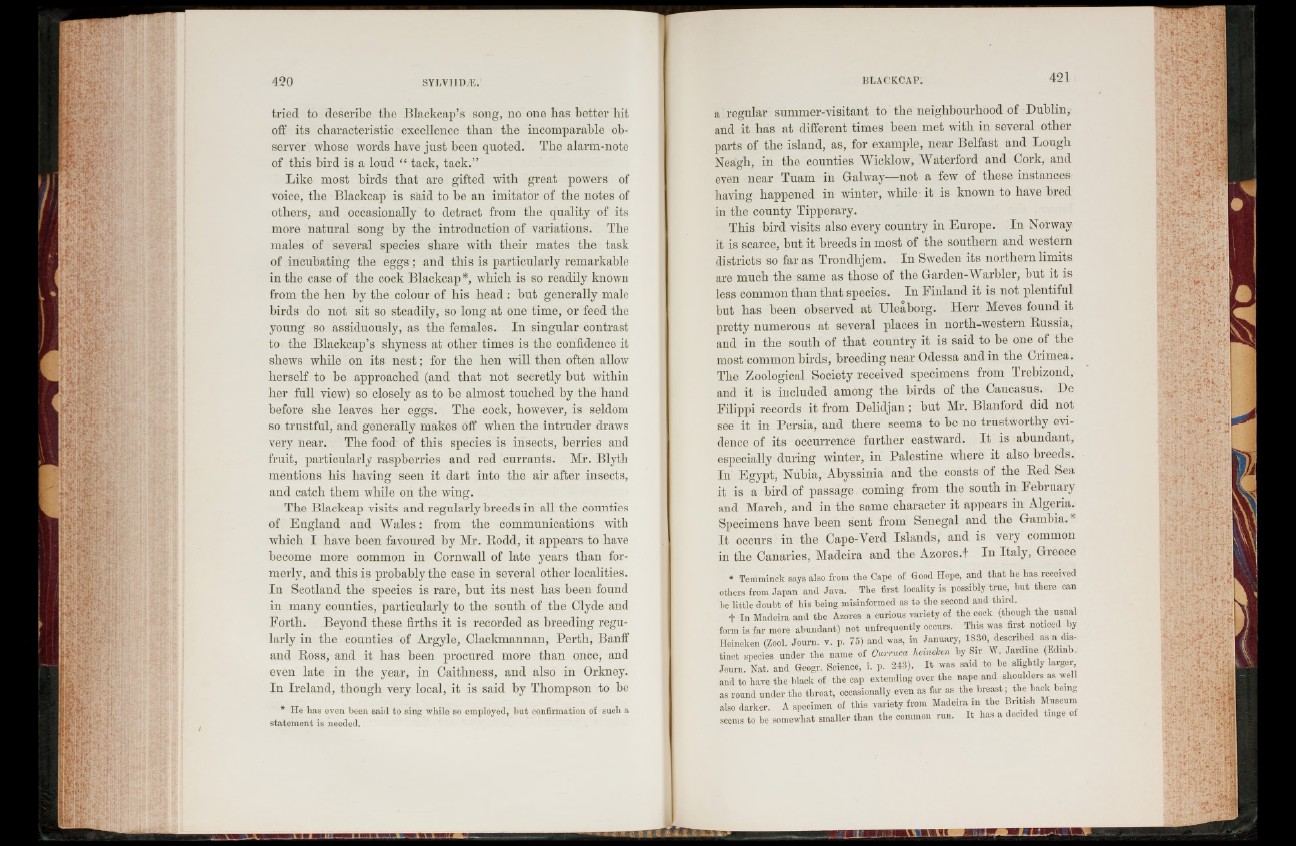
tried to describe tlie Blackcap’s song, no one has better hit
off its characteristic excellence than the incomparable observer
whose words have just heen quoted. The alarm-note
of this bird is a loud “ tack, tack.”
Like most birds that are gifted with great powers of
voice, the Blackcap is said to be an imitator of the notes of
others, and occasionally to detract from the quality of its
more natural song by the introduction of variations. The
males of several species share with their mates the task
of incubating the eggs; and this is particularly remarkable
in the case of the cock Blackcap *, which is so readily known
from the hen by the colour of his head : but generally male
birds do not sit so steadily, so long at one time, or feed the
young so assiduously, as the females. In singular contrast
to the Blackcap’s shyness at other times is the confidence it
shews while on its n e s t; for the hen will then often allow
herself to be approached (and that not secretly but within
her full view) so closely as to be almost touched by the hand
before she leaves her eggs. The cock, however, is seldom
so trustful, and generally makes off when the intruder draws
very near. The food of this species is insects, berries and
fruit, particularly raspberries and red currants, Mr. Blytli
mentions his having seen it dart into the air after insects,
and catch them while on the wing.
The Blackcap visits and regularly breeds in all the counties
of England and Wales: from the communications with
which I have been favoured by Mr. Bodd, it appears to have
become more common in Cornwall of late years than formerly,
and this is probably the case in several other localities.
In Scotland the species is rare, but its nest has been found
in many counties, particularly to the south of the Clyde and
Forth. Beyond these firths it is recorded as breeding regularly
in the counties of Argyle, Clackmannan, Perth, Banff
and Ross, and it has been procured more than once, and
even late in the year, in Caithness, and also in Orkney.
In Ireland, though very local, it is said by Thompson to be
* He lias even been said to sing while so employed, but confirmation of sucli a
statement is needed.
a regular summer-visitant to the neighbourhood of Dublin,
and it has at different times been met with in several other
parts of the island, as, for example, near Belfast and Lough
Neagh, in the counties Wicklow, Waterford and Cork, and
even near Tuam in Galway—not a few of these instances
having happened in winter, while it is known to have bred
in the county Tipperary.
This bird visits also every country in Europe. In Norway
it is scarce, but it breeds in most of the southern and western
districts so far as Trondhjem. In Sweden its northern limits
are much the same as those of the Garden-Warbler, but it is
less common than that species. In Finland it is not plentiful
but has been observed at Uleaborg. Herr Meves found it
pretty numerous at several places in north-western Russia,
and in the south of that country it is said to be one of the
most common birds, breeding near Odessa and in the Crimea.
The Zoological Society received specimens from Trebizond,
and it is included among the birds of the Caucasus. De
Filippi records it from Delidjan; but Mr. Blanford did not
see it in Persia, and there seems to be no trustworthy evidence
of its occurrence further eastward. I t is abundant,
especially during winter, in Palestine where it also breeds.
In Egypt, Nubia, Abyssinia and the coasts of the Red Sea
it is a bird of passage coming from the south in February
and March, and in the same character it appears in Algeria.
Specimens have heen sent from Senegal and the Gambia.
It occurs in the Cape-Verd Islands, and is very common
in the Canaries, Madeira and the Azores.! In Italy, Gieece
* Temminck says also from the Cape of Good Hope, and that he has received
others from Japan and Java. The first locality is possibly true, but there can
be little doubt of his being misinformed as to the second and third.
t In Madeira and the Azores a curious variety of the cock (though the usual
form is far more abundant) not unfrequently occurs. This was first noticed ^by
Heineken (Zool. Journ. v. p. 75) and was, in January, 1830, described asis^distinct
species under the name of Curruca heineken by Sir W. Jardme (Edmb.
Journ. Nat. and Geogr. Science, i. p. 243). I t was said to be slightly larger
and to have the black of the cap extending over the nape and shoulders as well
as round under the throat, occasionally even as far as the breast; the back being
also darker. A specimen of this variety from Madeira m the British Museum
seems to be somewhat smaller than the common run. I t has a decided tinge o